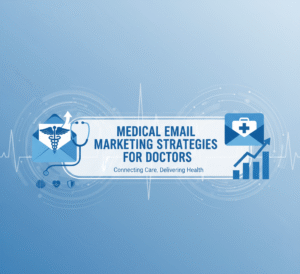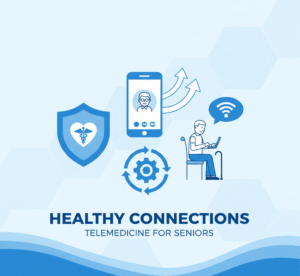“Optimize your medical practice’s online presence with Local SEO for Doctors to attract nearby patients in your city.”
In today’s fast-paced digital world, finding a doctor has changed dramatically. Gone are when patients relied solely on word-of-mouth referrals or the Yellow Pages. When someone needs medical attention, their first instinct is often to reach for their smartphone or computer. They type phrases like “pediatrician near me,” “dermatologist in Dublin,” or “best cardiologist in [your city]” into a search engine. This shift makes local SEO essential for doctors in any medical practice aiming to thrive.
If your medical practice isn’t showing up prominently in these local searches, you’re missing out on many potential patients. This article dives deep into local SEO strategies tailored specifically for healthcare professionals. We’ll explore how local search optimization for healthcare works, why it matters so much, and actionable steps you can take to make your clinic highly visible to nearby patients.
What Exactly is Local SEO for Doctors?
Local SEO for doctors is a specialized online marketing approach focusing on making your medical practice visible in online search results for people in your specific geographic area. While general SEO aims for national or even global visibility, local SEO zeros in on your city, your neighborhood, or the region you serve.
This strategy involves optimizing your online presence so that when someone nearby searches for medical services you offer, your practice appears at the top of their results. It’s about connecting with individuals actively looking for care in your vicinity. This often means showing up in Google’s “Map Pack” – the prominent box with a map and three local business listings that appears at the top of many local search results.
The core idea is simple: people seek medical services near their home or workplace. Effective local search optimization ensures your practice is easy to find for these “near me” searches, translating directly into more calls, website visits, and ultimately, more appointments.
Why Does Local SEO Matter So Much for Healthcare?
The impact of local SEO on medical practices cannot be overstated. It’s a fundamental part of healthcare digital marketing. Here’s why dedicating resources to it will benefit your clinic significantly:
1. Increased Visibility in Local Search Results
First and foremost, local SEO boosts your visibility. When prospective patients search for a doctor, they rarely look beyond the first page of results. If your practice isn’t there, it might not exist to them. By optimizing for local search, you significantly increase the chances of your clinic appearing prominently, especially in the coveted Google Map Pack. This direct visibility is a game-changer for attracting new patients.
2. Attracting “Near Me” Searches
“Near me” searches are incredibly powerful for local businesses, and medical practices are no exception. Patients often need immediate or convenient care. When they search for “urgent care near me” or “dentist near me,” they express a clear intent to find a local provider immediately. Robust local SEO strategies for clinics directly address this intent, guiding these ready-to-book patients straight to your door. Converting these “near me” searches into actual walk-ins or scheduled appointments is a primary goal.
3. Building Patient Trust and Credibility
Online reviews play a massive role in patient decision-making. A strong local SEO presence often goes hand-in-hand with a robust online review strategy. When your practice appears in local search results with numerous positive reviews, it builds trust and credibility. Patients see what others have experienced, and positive feedback is a powerful endorsement. This public validation is crucial for establishing your practice as a reliable and trustworthy healthcare provider in the community.
4. Driving More Website Traffic and Appointments
Higher rankings directly translate to more clicks on your website. Once patients land on your site, if it’s well-designed and informative, they are more likely to take the next step: scheduling an appointment. Local SEO brings visitors to your digital doorstep and pre-qualifies them as geographically relevant leads. This targeted traffic is far more valuable than general traffic outside your service area. The goal is to turn online interest into real-world patient foot traffic.
5. Gaining a Competitive Edge
Many medical practices still haven’t fully embraced local SEO. This presents a massive opportunity for those who do. Investing in local search optimization can quickly outrank competitors who neglect their presence. This competitive advantage helps you capture a larger share of the local patient market. It positions your practice as a modern, accessible, and preferred choice in your community.
6. Reducing Reliance on Paid Advertising
While paid ads can offer immediate visibility, they come at a recurring cost. Effective local SEO, on the other hand, provides sustained, organic visibility. Once your local rankings for doctors improve, you can often maintain that position with ongoing optimization, reducing your long-term reliance on expensive ad campaigns. This makes your patient acquisition efforts more sustainable and cost-effective over time.
Essential Local SEO Strategies for Doctors and Clinics
Now that we understand why local SEO is crucial, let’s break down the actionable strategies to help your practice rank higher and bring in nearby patients. These medical SEO strategies are practical and designed for real-world application.
1. Optimizing Your Google Business Profile (GBP)
Your Google Business Profile (formerly Google My Business) is the cornerstone of local SEO for doctors. It’s often the first thing potential patients see when searching for regional healthcare providers, so optimizing it correctly is paramount.
- Claim and Verify Your Profile: If you haven’t already, claim your GBP listing. Google will send a verification code, usually by mail, to confirm your location. This is a crucial first step.
- Complete All Information Fields: Complete every section of your profile thoroughly. This includes your exact business name, address, phone number (NAP—Name, Address, Phone), website, hours of operation (including holiday hours), and detailed description of your services. Inconsistent NAP information across the web can hurt your rankings, so ensure it’s uniform everywhere.
- Choose Accurate Categories: Select the most relevant primary and secondary categories for your practice. For instance, if you’re a general practitioner, “Physician” or “Family Doctor” might be primary, with “General Practice” as secondary. Specificity helps Google understand what your practice does.
- Add High-Quality Photos: Include clear, professional photos of your clinic’s exterior, interior, waiting room, examination rooms, and staff. Visuals make your profile more appealing and trustworthy. Patients want to see where they’ll be going.
- Utilize Google Posts: Regularly publish Google Posts to share updates, news, special offers, health tips, or announcements. These posts appear directly on your GBP and can engage potential patients.
- Answer Questions and Messages: Respond promptly to any questions users post on your GBP. Enable messaging to allow direct communication, showing you are accessible and responsive.
- List Services and Products: List all the medical services you offer. This helps Google match your practice with relevant patient searches.
2. Generating and Managing Local Reviews
Patient reviews are arguably the most powerful ranking factor and trust signal in local SEO for medical practices. Patients rely heavily on peer experiences.
- Encourage Reviews Actively: Don’t just hope for reviews; actively ask for them. Train your front office staff to ask satisfied patients to leave a review on Google politely. You can also send follow-up emails or texts with a direct link to your Google review page. Make the process as easy as possible.
- Respond to All Reviews (Positive and Negative): This is critical. For positive reviews, thank the patient and reinforce their positive experience. For negative reviews, respond professionally, empathetically, and constructively. Do not get defensive. Offer to resolve issues offline. A thoughtful response to a negative review can turn a bad experience into a positive impression for future patients. Remember, responding shows you care about patient feedback.
- Monitor Reviews Regularly: Stay on top of new reviews. Google and other platforms (like Healthgrades, Zocdoc, and WebMD) are dynamic. Set up alerts, or make it a routine to check for new feedback.
- Leverage Review Platforms Beyond Google: While Google is primary, encourage reviews on other relevant healthcare directories and social media platforms. A diverse set of positive reviews across different sites further builds credibility.
3. Using Geo-Targeted Keywords Effectively
Keywords are the bridge between what patients search for and your practice. Geo-targeted keywords specifically include location-based terms.
- Local Keyword Research: Think like a patient. What terms would they use to find a doctor like you in your area? Use tools like Google Keyword Planner or SEMrush to find location-specific search volumes. Combine your specialty with city names, neighborhoods, or “near me” phrases (e.g., “urgent care clinic downtown,” “pediatric dentist Brooklyn,” “physician near me”).
- Integrate Keywords Naturally: Once you have your list, weave these keywords naturally into your website content, blog posts, GBP description, and even image alt text. Avoid keyword stuffing, which can hurt your rankings. The content should always be helpful and readable for humans first.
- Create Location-Specific Pages: If you have multiple clinic locations or serve distinct neighborhoods within a city, consider creating dedicated landing pages for each location. Each page should be optimized with specific local keywords and NAP information for that location.
4. Building Local Citations
Local citations mention your practice’s NAP (Name, Address, Phone Number) on other websites. These can be in online directories, business listings, or local news sites.
- Consistency is Key: Ensure your NAP information is identical across all online directories and platforms. Any inconsistencies (e.g., “St.” vs. “Street”) can confuse search engines and hurt your local rankings.
- Prioritize Major Directories: List your practice on major healthcare directories (e.g., Healthgrades, Zocdoc, WebMD, Vitals, Doximity), general business directories (e.g., Yelp, Yellow Pages, Foursquare), and local chambers of commerce.
- Industry-Specific Directories: Look for medical or specialty-specific directories relevant to your practice.
- Manual Submission and Monitoring: While some services can automate this, manually submitting to top-tier directories and regularly auditing your citations for accuracy is a best practice. Remove duplicate listings.
5. Website Optimization for Local SEO (Technical & User Experience)
Your website serves as your practice’s digital front door. It must be optimized both technically and for a smooth user experience.
- Mobile-Friendliness: The vast majority of local searches happen on mobile devices. Your website must be responsive and load quickly on smartphones and tablets. Google prioritizes mobile-first indexing.
- Website Speed: Patients are impatient, and a slow-loading website will deter them. Optimize images, leverage browser caching, and consider a reliable hosting provider to ensure your site loads swiftly.
- Secure Site (HTTPS): Ensure your website uses HTTPS (secure connection). This is a basic security measure and a ranking factor. It protects patient data and builds trust.
- Clear Calls to Action (CTAs): Make it easy for patients to schedule an appointment, call your office, or fill out a contact form. Place clear CTAs prominently throughout your site.
- Patient Testimonials and Case Studies: If appropriate and with patient consent, dedicate a section to patient testimonials and de-identified case studies. This reinforces the trust built through reviews and demonstrates your expertise.
- Intuitive Navigation: Design your website with straightforward, easy-to-understand navigation. Patients should quickly find information about services, doctors, accepted insurance, and contact details.
6. Creating Patient-Focused Content (Content Marketing)
Content is king, even in healthcare. Regularly creating high-quality, informative content helps establish your authority and answers common patient questions.
- Blog Posts on Health Topics: Write blog posts that address common health concerns, explain medical conditions, or offer preventative health tips relevant to your specialty. For example, a pediatrician might blog about “common childhood fevers” or “vaccination schedules.”
- Educational Resources: Develop FAQs, guides, or infographics on various health topics. This positions your practice as a valuable resource for health information.
- Local Relevance in Content: Weave local context into your content whenever possible. Discuss local health trends, participate in community health initiatives, or highlight local events your practice is involved in.
- Demonstrate Expertise, Experience, Authority, and Trust (E-E-A-T): Google heavily emphasizes E-E-A-T, especially for “Your Money, Your Life” (YMYL) topics like health. Ensure your content is accurate, evidence-based, written by or reviewed by qualified medical professionals, and attributes sources. Include author bios for your doctors, highlighting their credentials and experience.
- Video Content: Create short, informative videos explaining procedures, offering health tips, or introducing your staff. Videos can be highly engaging, embedded on your website, and shared on social media.
7. Implementing Schema Markup (Structured Data)
Schema markup is a type of microdata you can add to your website’s HTML. It helps search engines better understand your pages’ content.
- Organization Schema: Use organization schema to provide details about your medical practice, such as its official name, address, contact information, and logo.
- Local Business Schema: This specific schema type helps define your business as a local entity, including opening hours, geographic area served, and accepted payment methods.
- Medical Specialty Schema: For doctors, you can use the medical specialty schema to specify your field (e.g., Physician, Dentist, Hospital).
- Review/Rating Schema: Markup your patient reviews and ratings so that they can appear as rich snippets in search results, making your listing more visually appealing and trustworthy.
- FAQPage Schema: If you have an FAQ section (which you should!), use FAQPage schema to make those questions and answers eligible for rich results in Google, appearing directly in search.
Implementing schema markup doesn’t directly improve rankings, but it significantly enhances how your practice appears in search results, leading to higher click-through rates.
Overcoming Common Challenges in Medical SEO
Doctors and clinics often face unique hurdles to improve their online visibility. Understanding these challenges helps in formulating effective strategies:
- Lack of Patient-First Content: Many medical websites are too technical or jargon-filled. Content must be accessible and directly answer patient queries in clear, understandable language. Focus on what patients want, not just what doctors want to say.
- Weak Local Signals: Sometimes, practices don’t fully leverage their local presence. This includes inconsistent NAP details, too few local reviews, or neglecting local citations. Strengthening these signals is vital.
- Poor Technical SEO: A slow, non-mobile-friendly, or insecure website will always struggle to rank. Investing in a technically sound website is a foundational requirement.
- Missing Google Trust: Google needs to trust your practice. This trust is built through a complete and active Google Business Profile, numerous positive reviews, and a high-quality, secure website that adheres to E-E-A-T guidelines.
- Privacy Barriers (HIPAA Compliance): Healthcare marketing must always adhere to strict privacy regulations like HIPAA. This means being careful with patient testimonials (getting proper consent), handling data securely, and avoiding public disclosure of protected health information. Your SEO efforts must integrate seamlessly with these compliance requirements.
Partner with InvigoMedia for Real Results
Navigating the complexities of local SEO for doctors can be daunting, especially when you’re focused on providing exceptional patient care. It requires time, expertise, and a deep understanding of digital marketing and the healthcare industry’s unique compliance requirements.
This is where a specialized medical digital marketing agency like InvigoMedia becomes an invaluable partner. We understand the nuances of healthcare SEO – from optimizing your Google Business Profile to generating authentic local reviews, implementing geo-targeted keywords, and building robust local citations. Our team has a proven track record of helping clinics and private practices increase their online visibility, attract more nearby patients, and ultimately, grow their patient base.
By entrusting your local SEO efforts to InvigoMedia, you free up valuable time to concentrate on what you do best: providing outstanding medical care. We develop tailored strategies that drive real results, helping your practice rank higher in your city, capture those crucial “near me” searches, and build lasting relationships with patients in your community. Contact InvigoMedia today to learn how we can help your practice thrive.
FAQs About Local SEO for Doctors
Q1: Is local SEO only for large hospitals, or does it apply to small clinics too?
A: Local SEO is vital for small clinics and private practices. It can be even more impactful for them. Small clinics often serve a particular local community, and local SEO is designed to connect you directly with patients in that precise geographic area. It helps you compete effectively with larger institutions by dominating local search results for your specialty.
Q2: How long does it take to see results from local SEO?
A: SEO is a long-term strategy, not a quick fix. You might start seeing some initial improvements in visibility within a few weeks or months, especially with Google Business Profile optimization. However, significant local rankings and patient acquisition improvements typically take 4 to 12 months, often longer for highly competitive markets. Consistency and ongoing effort are key to sustained success.
Q3: Do I need to have a blog on my medical website?
A: Yes, a blog is highly recommended. A well-maintained blog allows you to publish fresh, patient-focused content regularly. This content helps you rank for more keywords, establishes your practice as an authority on various health topics (improving your E-E-A-T), and provides valuable information that can build trust with potential patients. It’s an excellent way to address common patient questions and provide educational resources.
Q4: Should I worry about negative reviews? How do I handle them?
A: Negative reviews are almost inevitable for any business over time. Do not panic when you receive one. What matters is how you handle it. Always respond promptly, professionally, and empathetically. Acknowledge the patient’s concerns, express regret for their negative experience, and offer to resolve the issue offline (e.g., “Please call our office at [phone number] so we can discuss this further and find a resolution”). This shows that you are responsive and care about patient feedback, which can mitigate the negative impact for other potential patients reading the reviews.
Q5: Is using patient testimonials and success stories for SEO okay?
A: Patient testimonials and success stories are compelling for building trust and credibility. They provide social proof that your medical services are effective and valued. However, it is critical to obtain explicit, written consent from patients before using their names, images, or personal health information. You must strictly adhere to HIPAA regulations and other patient privacy laws. Deidentified testimonials (e.g., using only initials or first names with no other identifying details) are often used to maintain privacy while conveying positive feedback.
Q6: How often should I update my Google Business Profile?
A: You should keep your business Profile as current as possible. This means immediately updating hours for holidays or special closures, posting regularly about clinic news or health tips (at least once a week if possible), and responding to reviews and questions promptly. Treat your GBP as an active communication channel with your patients.
Q7: What is the role of video testimonials in medical SEO?
A: Video testimonials are highly engaging and build immense trust. Seeing and hearing a real patient describe their positive experience can be far more convincing than reading text. Consider adding video testimonials to your website and Google Business Profile if you can obtain them with full patient consent. They humanize your practice and provide compelling social proof, which can significantly influence patient acquisition.













